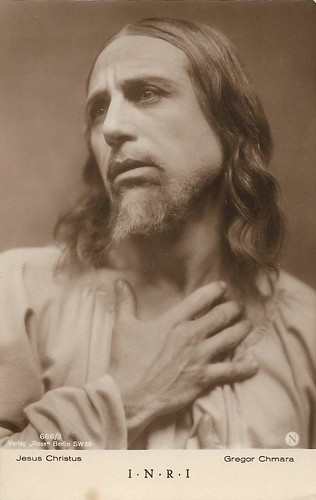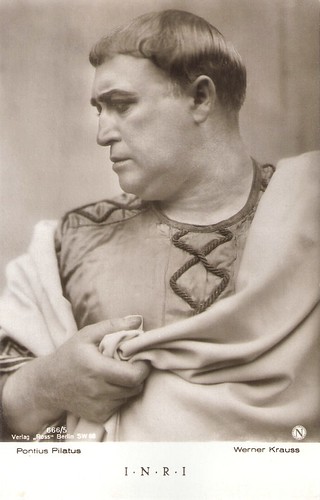The German silent film I.N.R.I. (1923), directed by Robert Wiene, was one of the first big-screen adaptations of the Passion of Christ. The film retells the events leading up to the crucifixion of Jesus. The Ukrainian born actor Gregori Chmara played Jesus Christ, Henny Porten the Virgin Mary and Alexander Granach Judas. Asta Nielsen also appeared as Maria Magdalen. I.N.R.I. was reissued in 1933 in the United States with an added music track and narration as Crown of Thorns.

German postcard by Ross Verlag, no. 666/1. Photo: Neumann. Henny Porten as Mary in I.N.R.I. (Robert Wiene, 1923).

German postcard by Ross Verlag, no. 666/3. Photo: Neumann. Gregori Chmara as Jesus Christ in I.N.R.I. (Robert Wiene, 1923).

German postcard by Ross Verlag, Berlin, no. 666/4. Photo: Neumann. Alexander Granach as Judas in I.N.R.I. (Robert Wiene, 1923).
I.N.R.I. (1923) was made by Robert Wiene, who had revolutionised the German cinema with his expressionist film Das Cabinet des Dr. Caligari/The Cabinet of Dr. Caligari (1920). He just had made Raskolnikow/Crime and Punishment (1923), also starring Gregori Chmara and the Moscow Art Theatre players.
Wiene had based I.N.R.I. on a 1905 novel by Peter Rosegger and he embedded the Passion of Christ in a contemporary story. The film is generally conventional in its treatment of the story except for the character of Judas Iscariot (Alexander Granach).
Wiene portrays Judas as a social revolutionary who wants Jesus (Gregori Chmara) to become the leader of a Jewish uprising against the Roman army of occupation. Judas' eventual betrayal of Jesus comes from political disillusionment rather than money. The Judas role is very important to the film as it was conceived by Wiene, because it links the biblical story to the framing story.
The framing story is set in modern Russia. An anarchist shoots the prime minister of his country out of political conviction. He is sentenced to death. A few hours before the execution, he starts doubting the meaning of his death and he decides to write down the Passion of Christ.
It is believed that Wiene intended the framing story to give the Biblical story an anti-Bolshevist propaganda function. However, the modern scenes provoked opposition from the censors, and the film was generally shown without them
IMDb suggests it was added without the knowledge of the actors in the Passion story, who included some of the major stars of the period: Asta Nielsen as the seductive Mary Magdalene, Henny Porten as Jesus' mother Mary, and Werner Krauss as Pontius Pilate. Krauss played the titular Dr Caligari in Wiene's famous film.

German postcard by Ross Verlag , Berlin, no. 666/5, 1919-1924. Photo: Neumann. Werner Krauss as Pontius Pilate in I.N.R.I. (Robert Wiene, 1923).

German postcard by Ross Verlag, Berlin, no. 666/6. Photo: Neumann. Theodor Becker as the Roman captain in I.N.R.I./Crown of Thorns (Robert Wiene, 1923).

German postcard by Ross Verlag, Berlin, no. 667/1. Photo: Neumann. The Nativity Scene with Henny Porten as Mary in I.N.R.I. (Robert Wiene, 1923).
I.N.R.I. (Robert Wiene, 1923) was shot over 90 days between May and September 1923 at the Staaken Studios in Berlin. The film was produced by Hans Neumann and Hans von Wolzogen for Neumann-Filmproduktion
I.N.R.I. was the first biblical epic made in Germany and it was made with expensive sets and hundreds of extras for the mass scenes. In scale and length, it was the largest film directed by Robert Wiene during his career. He had Ernö Metzner for the film's art direction and had three cinematographers to film his epic: Axel Graatkjær, Reimar Kuntze and Ludwig Lippert.
Edgar Mauricio, at his blog Stone Movie Spree, is impressed: "As for the staging, the work done by the expressionist master is impeccable, his setting is impeccable, the costumes, the decorations, without excessive ornaments or mannerisms, but a simplicity that leads to a more intimate closeness to what is portrayed, and it contrasts with the reloading efforts of representation that can be seen in these days, so artificial and pastiche that they end up eliminating a genuine approach to those days.
I.N.R.I. premiered in Berlin on Christmas Day 1925. The film received mixed reviews in the German newspapers and soon disappeared from the cinema screens.
For a long time I.N.R.I. was believed to be lost, but a surviving complete copy, a 16mm print, was discovered in the archives of the Cineteca del Friuli in Italy in October 1999. Since the film lacked opening credits, it had been labelled as an unknown film. Another copy was found in Japan and screened at National Film Center, Tokyo at February 2006. Although it looks like some scenes are missing, it is 35mm tinted print with English intertitles.

German postcard by Ross Verlag, Berlin, no. 667/2. Photo: Neumann. Gregori Chmara as Jesus Christ and Henny Porten as Mary in I.N.R.I. (Robert Wiene, 1923).

German postcard by Ross Verlag, Berlin, no. 667/3. Photo: Neumann. Gregori Chmara as Jesus Christ at the Last Supper in I.N.R.I. (Robert Wiene, 1923). Foreground right, looking up is Alexander Granach as Judas.

German postcard by Ross Verlag, Berlin, no. 667/4. Photo: Neumann. Asta Nielsen as Mary Magdalen and Henny Porten as the Virgin Mary in I.N.R.I. (Robert Wiene, 1923).
Sources: Edgar Mauricio (Stone Movies Spree), Ed Meza (Variety), Wikipedia and IMDb.

German postcard by Ross Verlag, no. 666/1. Photo: Neumann. Henny Porten as Mary in I.N.R.I. (Robert Wiene, 1923).

German postcard by Ross Verlag, no. 666/3. Photo: Neumann. Gregori Chmara as Jesus Christ in I.N.R.I. (Robert Wiene, 1923).

German postcard by Ross Verlag, Berlin, no. 666/4. Photo: Neumann. Alexander Granach as Judas in I.N.R.I. (Robert Wiene, 1923).
Judas as a social revolutionary
I.N.R.I. (1923) was made by Robert Wiene, who had revolutionised the German cinema with his expressionist film Das Cabinet des Dr. Caligari/The Cabinet of Dr. Caligari (1920). He just had made Raskolnikow/Crime and Punishment (1923), also starring Gregori Chmara and the Moscow Art Theatre players.
Wiene had based I.N.R.I. on a 1905 novel by Peter Rosegger and he embedded the Passion of Christ in a contemporary story. The film is generally conventional in its treatment of the story except for the character of Judas Iscariot (Alexander Granach).
Wiene portrays Judas as a social revolutionary who wants Jesus (Gregori Chmara) to become the leader of a Jewish uprising against the Roman army of occupation. Judas' eventual betrayal of Jesus comes from political disillusionment rather than money. The Judas role is very important to the film as it was conceived by Wiene, because it links the biblical story to the framing story.
The framing story is set in modern Russia. An anarchist shoots the prime minister of his country out of political conviction. He is sentenced to death. A few hours before the execution, he starts doubting the meaning of his death and he decides to write down the Passion of Christ.
It is believed that Wiene intended the framing story to give the Biblical story an anti-Bolshevist propaganda function. However, the modern scenes provoked opposition from the censors, and the film was generally shown without them
IMDb suggests it was added without the knowledge of the actors in the Passion story, who included some of the major stars of the period: Asta Nielsen as the seductive Mary Magdalene, Henny Porten as Jesus' mother Mary, and Werner Krauss as Pontius Pilate. Krauss played the titular Dr Caligari in Wiene's famous film.

German postcard by Ross Verlag , Berlin, no. 666/5, 1919-1924. Photo: Neumann. Werner Krauss as Pontius Pilate in I.N.R.I. (Robert Wiene, 1923).

German postcard by Ross Verlag, Berlin, no. 666/6. Photo: Neumann. Theodor Becker as the Roman captain in I.N.R.I./Crown of Thorns (Robert Wiene, 1923).

German postcard by Ross Verlag, Berlin, no. 667/1. Photo: Neumann. The Nativity Scene with Henny Porten as Mary in I.N.R.I. (Robert Wiene, 1923).
Expensive sets and hundreds of extras
I.N.R.I. (Robert Wiene, 1923) was shot over 90 days between May and September 1923 at the Staaken Studios in Berlin. The film was produced by Hans Neumann and Hans von Wolzogen for Neumann-Filmproduktion
I.N.R.I. was the first biblical epic made in Germany and it was made with expensive sets and hundreds of extras for the mass scenes. In scale and length, it was the largest film directed by Robert Wiene during his career. He had Ernö Metzner for the film's art direction and had three cinematographers to film his epic: Axel Graatkjær, Reimar Kuntze and Ludwig Lippert.
Edgar Mauricio, at his blog Stone Movie Spree, is impressed: "As for the staging, the work done by the expressionist master is impeccable, his setting is impeccable, the costumes, the decorations, without excessive ornaments or mannerisms, but a simplicity that leads to a more intimate closeness to what is portrayed, and it contrasts with the reloading efforts of representation that can be seen in these days, so artificial and pastiche that they end up eliminating a genuine approach to those days.
I.N.R.I. premiered in Berlin on Christmas Day 1925. The film received mixed reviews in the German newspapers and soon disappeared from the cinema screens.
For a long time I.N.R.I. was believed to be lost, but a surviving complete copy, a 16mm print, was discovered in the archives of the Cineteca del Friuli in Italy in October 1999. Since the film lacked opening credits, it had been labelled as an unknown film. Another copy was found in Japan and screened at National Film Center, Tokyo at February 2006. Although it looks like some scenes are missing, it is 35mm tinted print with English intertitles.

German postcard by Ross Verlag, Berlin, no. 667/2. Photo: Neumann. Gregori Chmara as Jesus Christ and Henny Porten as Mary in I.N.R.I. (Robert Wiene, 1923).

German postcard by Ross Verlag, Berlin, no. 667/3. Photo: Neumann. Gregori Chmara as Jesus Christ at the Last Supper in I.N.R.I. (Robert Wiene, 1923). Foreground right, looking up is Alexander Granach as Judas.

German postcard by Ross Verlag, Berlin, no. 667/4. Photo: Neumann. Asta Nielsen as Mary Magdalen and Henny Porten as the Virgin Mary in I.N.R.I. (Robert Wiene, 1923).
Sources: Edgar Mauricio (Stone Movies Spree), Ed Meza (Variety), Wikipedia and IMDb.
No comments:
Post a Comment